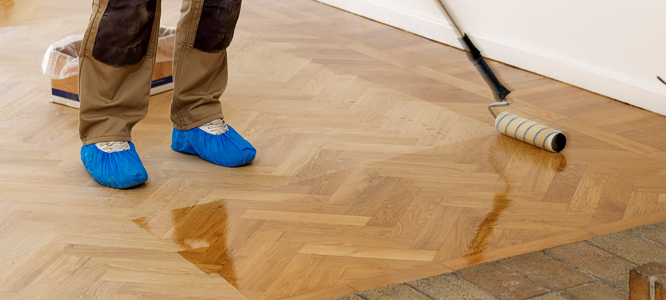Wondering if you can varnish laminate flooring to give it new life? The answer might surprise you – and save you from a costly mistake.
Understanding Laminate Flooring: Why Varnishing Isn’t The Answer
Laminate flooring is an engineered product that consists of multiple layers, with a high-resolution photographic layer protected by a hard-wearing transparent coating. The top wear layer is specifically designed to be extremely durable and resistant to scratches, stains, and UV damage. This layer is factory-sealed and engineered to provide optimal protection without requiring additional treatments. Modern laminate flooring typically comes with a 15-25 year warranty, demonstrating its inherent durability. Attempting to varnish laminate flooring can actually compromise this carefully engineered system, as the surface is not designed to bond with additional finishes. The wear layer’s smooth, non-porous nature means that varnish cannot penetrate or properly adhere to the surface, making any attempt to varnish not only ineffective but potentially harmful to your flooring investment.
The Risks of Varnishing Laminate Floors
- Poor Adhesion: Varnish cannot bond properly with the non-porous laminate surface, leading to peeling, bubbling, and uneven coverage
- Safety Hazards: Varnished laminate becomes extremely slippery, increasing the risk of accidents and falls
- Permanent Damage: The chemicals in varnish can react with the wear layer, causing discolouration or degradation
- Warranty Voiding: Most manufacturers explicitly state that applying varnish or other surface treatments will void the product warranty
- Aesthetic Issues: Uneven application and poor adhesion can result in a patchy, unprofessional appearance
Better Alternatives to Varnishing
Instead of reaching for varnish, there are several effective methods to restore and maintain your laminate flooring’s appearance. Professional cleaning solutions specifically designed for laminate can remove up to 99% of surface dirt and restore shine. Consider using pH-neutral cleaners that won’t damage the wear layer, and invest in microfibre mops that effectively clean without scratching. For deeper cleaning, steam cleaning can be effective when used correctly, though it’s essential to use equipment specifically approved for laminate flooring. Some manufacturers also offer specialised restoration products that can help minimise the appearance of minor scratches and restore the floor’s original lustre.
When to Consider Replacement Instead
There comes a point when restoration efforts may not be sufficient, and replacement becomes the most practical solution. According to industry statistics, laminate flooring typically needs replacement after 15-25 years of regular use. Signs that indicate replacement might be necessary include:
- Deep scratches or gouges that penetrate the wear layer
- Widespread discolouration or fading that affects more than 30% of the surface
- Water damage causing swelling or separation of boards
- Clicking or hollow sounds when walking on the floor
- Visible wear patterns in high-traffic areas
Professional Solutions for Worn Laminate Flooring
Professional flooring specialists can offer various solutions to extend the life of your laminate flooring. These experts can perform detailed assessments to determine the best course of action, whether it’s deep cleaning, board replacement, or full floor renewal. Professional restoration services can extend the life of your laminate flooring by 3-5 years when performed correctly. They use industrial-grade cleaning equipment and products that aren’t available to consumers, achieving superior results compared to DIY methods. Additionally, professionals can provide valuable advice on maintaining your floors and preventing future damage.
Expert Tips for Maintaining Laminate Floor Shine
- Daily Maintenance: Sweep or vacuum regularly using soft-bristled attachments to prevent scratch-causing debris
- Proper Cleaning: Use only manufacturer-approved cleaning products and avoid excess water
- Preventive Measures: Place doormats at entrances and use felt pads under furniture legs
- Spill Management: Clean spills immediately to prevent water damage and staining
- Climate Control: Maintain consistent room temperature and humidity levels to prevent expansion and contraction
Final Thoughts: Making the Right Choice for Your Floors
While it might be tempting to varnish your laminate flooring in an attempt to restore its appearance, this approach is likely to cause more harm than good. The key to maintaining beautiful laminate floors lies in proper care and maintenance rather than additional finishes. By following manufacturer guidelines and implementing proper care routines, you can maintain your laminate flooring’s appearance and extend its lifespan significantly. If your floors are showing signs of wear, consult with a flooring professional to explore appropriate restoration options or determine if replacement might be the better investment. Remember, proper maintenance can extend your laminate flooring’s life by up to 50%, making it a worthwhile investment in your home’s future.
FAQ
Can you use Bona Shine on laminate floors?
No matter what kind of hard-surface floor you have, Bona Hard-Surface Floor Polish has you covered. Bona Hard-Surface Floor Polish is formulated for a wide range of surfaces like linoleum, stone, terrazzo, vinyl, sealed porous marble, laminate, luxury vinyl and no-wax sealed tile (ceramic, Mexican Saltillo, quarry).
What should you not clean laminate floors with?
Maintaining Laminate Flooring Harsh cleaners, such as those with bleach, can cause damage, and sudsy cleaners can leave behind sticky residue that collects dirt.
What is the best way to shine laminate floors?
Although laminate floors aren’t solid wood, a thin layer of beeswax can help protect against minor scratches and give a slight shine. Apply sparingly and rub to avoid a slippery residue.
Can you sand and varnish laminate?
Sanding and finishing laminate flooring, although not a common practice, can potentially rejuvenate your floor, making it look new and vibrant. Remember, this process requires a gentle touch and a good understanding of the material you are working with.
Sources
[1] https://flooringvillage.co.uk/can-you-paint-or-stain-laminate-flooring/
[2] https://www.askaboutmoney.com/threads/laminate-floor-floor-varnish.123929/
[3] https://www.doityourself.com/stry/can-i-apply-a-polyurethane-finish-on-my-laminate-floors



